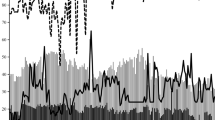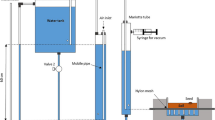Abstract
Aims
Seed germination is one of the most important processes in plant biology and ecology because it determines the timing and magnitude of seedling emergence events every growing season influencing community dynamics. Our aim was to determine whether polyethylene glycol (PEG) solutions simulate soil water potential accurately and recreate germination responses to soil water availability.
Methods
In this study, we compared seed germination of four plant species in PEG and four soils with different textures under six water potentials under controlled laboratory conditions.
Results
Total seed germination for all species significantly differed between soil and PEG under the same water potentials, as well as among soil water potentials for each of PEG and soil materials. Due to the inconsistent total germination associated with soil water potential, we evaluated unsaturated soil hydraulic conductivity (Kh) as a predictor of germination. The germination of all species followed the same response to Kh. Germination rate (GR50) was more directly related to water potential than total germination, but Kh provided a more robust description of GR50 across species and soils than PEG-osmotic potentials.
Conclusions
Our findings showed that Kh is a more informative variable to predict both total seed germination and germination rate in soil, and caution must be used when considering results obtained using PEG solutions to infer germination behavior under field conditions.






Similar content being viewed by others
Abbreviations
- Kh :
-
Unsaturated soil hydraulic conductivity
- PEG:
-
Polyethylene glycol
References
Abdellaoui R, Boughalleb F, Zayoud D, Neffati M, Bakhshandeh E (2019) Quantification of Retama raetam seed germination response to temperature and water potential using hydrothermal time concept. Environ Exp Bot 157:211–216
Allen PS, Meyer SE, Khan MA (2000) Hydrothermal time as a tool in comparative germination studies. In: Black M, Bradford KJ, Vizquez-Ramos J (eds) Seed biology: advances and applications. CABI Publishing, Wallingford
Bakhshandeh E, Jamali M, Afshoon E, Gholamhossieni M (2017) Using hydrothermal time concept to describe sesame (Sesamum indicum L.) seed germination response to temperature and water potential. Acta Physiol Plant 39:250
Bewley JD, Bradford KJ, Hilhorst HWM, Nonogaki H (2013) Environmental regulation of dormancy and germination. In: Bewley JD, Bradford K, Hilhorst H (eds) Seeds: physiology of development, germination and dormancy, 3rd edn. Springer, New York
Bidgoly RO, Balouchi H, Soltani E, Moradi A (2018) Effect of temperature and water potential on Carthamus tinctorius L. seed germination: quantification of the cardinal temperatures and modeling using hydrothermal time. Ind Crop Prod 113:121–127
Boddy LG, Bradford KJ, Fischer AJ (2013) Stratification requirements for seed dormancy alleviation in a wetland weed. PLoS One 8:e71457
Bradford KJ (2002) Applications of hydrothermal time to quantifying and modeling seed germination and dormancy. Weed Sci 50:248–260
Buhler DD, Hartzler RG, Forcella F (1997) Implications of weed seedbank dynamics to weed management. Weed Sci 45:329–336
Bullied WJ, Van Acker RC, Bullock PR (2012) Hydrothermal modeling of seedling emergence timing across topography and soil depth. Agron J 104:423–436
Collis-George N, Hector JB (1966) Germination of seeds as influenced by matric potential and by area of contact between seed and soil water. Aust J Soil Res 4:145–146
Collis-George N, Melville MD (1975) Water absorption by swelling seeds. I. Constant surface boundary condition. Soil Res 13:141–158
Collis-George NJ, Sands E (1959) The control of seed germination by moisture as a soil physical property. Aust J Agric Res 10:628–636
Dasberg S (1971) Soil water movement to germinating seeds. J Exp Bot 22:999–108
Dasberg S, Mendel K (1971) The effect of soil water and aeration on seed germination. J Exp Bot 22:992–998
Davis DD, Horton R, Heitman JL, Ren T (2009) Wettability and hysteresis effects on water sorption in relatively dry. Soil Sci Soc Am J 73:1947–1951
Forcella F (1992) Prediction of weed seedling densities from buried seed reserves. Weed Res 32:29–38
Gee GW, Or D (2002) Particle size analysis. In: Dane JH, Topp GC (eds) Methods of soil analysis. Part 4. Physical methods. SSSA, Madison, pp 255–293
Hadas A (1977) Water uptake and germination of leguminous seeds in soils of changing matric and osmotic water potential. J Exp Bot 28:977–985
Hadas A, Russo D (1974) Water uptake by seeds as affected by water stress, capillary conductivity, and seed-soil water contact. II. Analysis of experimental data. Agron J 66:648–652
Hardegree SP, Emmerich WE (1994) Seed germination response to polyethylene glycol solution depth. Seed Sci Technol 22:1–7
Hillel D (1972) Soil moisture and seed germination. In: Kozlowski TT (ed) Water deficits and plant growth, vol 3. Academic, New York, pp 65–89
Hillel D (1998) Environmental soil physics. Academic, San Diego
International Seed Testing Association (1985) International rules for seed testing. Seed Sci Technol 13:300–520
Kaufmann MR, Ross KJ (1970) Water potential, temperature, and kinetin effects on seed germination in soil and solute systems. Am J Bot 57:413–419
Klute A (1986) Water retention: laboratory methods. In: Klute A (ed) Methods of soil analysis. Part 1. Physical and mineralogical methods. SSSA, Madison, pp 635–662
Klute A, Dirksen C (1986) Hydraulic conductivity of saturated soils. In: Klute A (ed) Methods of soil analysis. Part 1. Physical and mineralogical methods. SSSA, Madison, pp 694–700
Koller D, Hadas A (1982) Water relations in the germination of seeds. In: Lange OL, Nobel PS, Osmond CB, Ziegler H (eds) Physiological plant ecology II. Encyclopedia of plant physiology. New series vol. 12B. Springer-Verlag, Berlin, pp 401–431
Lamichhane JR, Debaeke P, Steinberg C, You MP, Barbetti MJ, Aubertot JN (2018) Abiotic and biotic factors affecting crop seed germination and seedling emergence: a conceptual framework. Plant Soil 432:1–28
Mehlich A (1984a) Photometric determination of humic matter in soils, a proposed method. Commun Soil Sci Plant Anal 15:1417–1422
Mehlich A (1984b) Mehlich-3 soil test extractant: a modification of Mehlich-2 extractant. Commun Soil Sci Plant Anal 15:1409–1416
Mehlich A, Bowling SS, Hatfield AL (1976) Buffer pH acidity in relation to nature of soil acidity and expression of lime requirement. Commun Soil Sci Plant Anal 7:253–263
Michel BE (1983) Evaluation of the water potentials of solutions of polyethylene glycol 8000 both in the absence and presence of other solutes. Plant Physiol 72:66–70
Michel BE, Kaufmann MR (1973) The osmotic potential of polyethylene glycol 6000. Plant Physiol 51:914–916
Mobli A, Ghanbari A, Rastgoo M (2018) Determination of cardinal temperatures of flax-leaf alyssum (Alyssum linifolium) in response to salinity, pH, and drought stress. Weed Sci 66:470–476
Mondoni A, Rossi G, Orsenigo S, Probert RJ (2012) Climate warming could shift the timing of seed germination in alpine plants. Ann Bot 110:155–164
Money NP (1989) Osmotic pressure of aqueous polyethylene glycols: relationship between molecular weight and vapor pressure deficit. Plant Physiol 91:766–769
Ooi MK (2012) Seed bank persistence and climate change. Seed Sci Res 22:S53–S60
Ooi MK, Auld TD, Denham AJ (2009) Climate change and bet-hedging: interactions between increased soil temperatures and seed bank persistence. Glob Chang Biol 15:2375–2386
Peck AJ, Luxmoore RJ, Stolzy JL (1977) Effects of spatial variability of soil hydraulic properties in water budget modeling. Water Resour Res 13:348–354
Pedroso RM, van Kessel C, Neto DD, Linquist BA, Boddy LG, Al-Khatib K, Fischer AJ (2020) ALS inhibitor–resistant smallflower umbrella sedge (Cyperus difformis) seed germination requires fewer growing degree days and lower soil moisture. Weed Sci 68:51–62
Porporato A, Daly E, Rodriguez-Iturbe I (2004) Soil water balance and ecosystem response to climate change. Am Nat 164:625–632
R Studio Team (2015) RStudio: integrated development for R. RStudio, Inc., Boston Available in http://www.rstudio.com/. Accessed 30 Jul 2020
Rogers RB, Dubetz S (1980) Effect of soil-seed contact on seed imbibition. Can Agric Eng 22:89–92
Roy JL, McGill WB (2000) Flexible conformation in organic matter coatings: an hypothesis about soil water repellency. Can J Soil Sci 80:143–152
Topp GC, Ferré PA (2002) The soil solution phase. In: Dane JH, Topp GC (eds) Methods of soil analysis. Part 4. Physical methods. SSSA, Madison, pp 417–1074
Tucker MR (1984) Volumetric measures for routine soil testing. Commun Soil Sci Plant Anal 15:833–840
van Genuchten MT (1980) A closed-form equation for predicting the hydraulic conductivity of unsaturated soils. Soil Sci Soc Am J 44:892–898
Vepraskas MJ, Caldwell PV (2008) Interpreting morphological features in wetland soils with a hydrologic model. Catena 73:153–165
Vertucci CW (1989) The kinetics of seed imbibition: controlling factors and relevance to seedling vigour. In: Stanwood PC, MacDonald MB (eds) Seed moisture. CSSA, Madison, pp 93–115
Vogel T, van Genuchten MT, Cislerova M (2000) Effect of the shape of the soil hydraulic functions near saturation on variably-saturated flow predictions. Adv Water Resour 24:133–144
Walck JL, Hidayati SN, Dixon KW, Thompson KEN, Poschlod P (2011) Climate change and plant regeneration from seed. Glob Chang Biol 17:2145–2216
Ward J, Shaykewich CF (1972) Water absorption by wheat seeds as influenced by hydraulic properties of soil. Can J Soil Sci 52:99–105
Williams J, Shaykewich CF (1971) Influence of soil water matric potential and hydraulic conductivity on the germination of rape (Brassica napus L.). J Exp Bot 22:586–597
Wuest SB, Albrecht SL, Skirvin KW (1999) Vapor transport vs. seed–soil contact in wheat germination. Agron J 91:783–787
Acknowledgements
We would like to thank Adam Howard for his valuable help with soil physical analyses. We also thank Dr. Theresa Reinhardt Piskackova, Sandy Ramsey, Joseph Hunter III and Alyssa Zsido for technical assistance.
Funding
This research was funded by USDA-NIFA Grants 2017-6505-26807, 2018-70006-28933, 2019-68012-29818, and Hatch Project NC02653.
Author information
Authors and Affiliations
Contributions
M.E.C., J.L.H., T.W.G, A.A., and R.G.L. designed research; M.E.C. performed research; M.E.C., J.L.H., and R.G.L analysed data; and M.E.C., J.L.H., T.W.G, A.A., and R.G.L. wrote the paper.
Corresponding author
Ethics declarations
Competing interests
We declare we have no competing interest.
Additional information
Responsible Editor: Susan Schwinning .
Publisher’s note
Springer Nature remains neutral with regard to jurisdictional claims in published maps and institutional affiliations.
Highlight
• Unsaturated soil hydraulic conductivity describes more accurately and consistently seed germination across species and soil types than water potential determined with PEG osmotic solutions.
Rights and permissions
About this article
Cite this article
Camacho, M.E., Heitman, J.L., Gannon, T.W. et al. Seed germination responses to soil hydraulic conductivity and polyethylene glycol (PEG) osmotic solutions. Plant Soil 462, 175–188 (2021). https://doi.org/10.1007/s11104-021-04857-5
Received:
Accepted:
Published:
Issue Date:
DOI: https://doi.org/10.1007/s11104-021-04857-5




